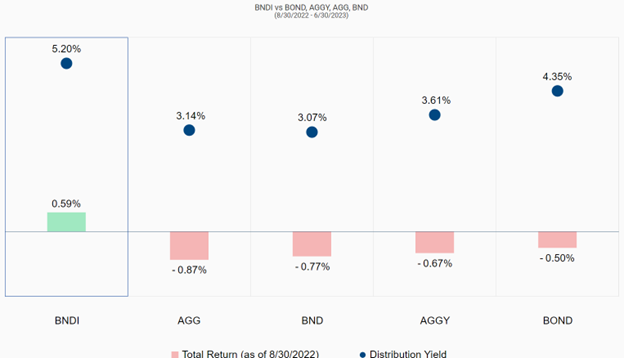The Fed raised rates once again in July, but it indicated a pause at minimum in its aggressive rate hiking regime. As bonds catch a breather from ratcheting rates, advisors and investors looking to augment and enhance their fixed income potential should consider the NEOS Enhanced Income Aggregate Bond ETF (BNDI).

BNDI continues to generate consistent outperformance amongst core fixed income ETFs since its inception last year. Between August 30, 2022, and June 30, 2023, BNDI generated total returns of 0.59%. All other core bond exposures, including the popular iShares Core U.S. Aggregate Bond ETF (AGG) and the Vanguard Total Bond Market ETF (BND), generated negative total returns over the same period.
When it comes to distribution yield, the fund also outperforms core allocations. BNDI had a distribution yield of 5.20%, compared to the AGG’s 3.14% and BND’s 3.07%.
Enhancing Fixed Income With Equity Options
The fund invests in BND and the AGG. However, the income and capital gains that BNDI receives from its bond allocations are enhanced by the addition of monthly income from the fund’s put-option strategy on the S&P 500. The strategy includes selling short puts and buying long puts to protect against volatility.
Advisors and investors looking to optimize income in bonds should consider BNDI. As of the end of June, BNDI had a distribution yield of 5.20% and a 30-day SEC yield of 2.25% (excludes income from options).
The strategy may offer positive returns in both flat and rising equity markets. It may also generate positive returns in moderately declining equity markets. This is possible if the premium from the puts bought and sold is greater than the cost to close out the positions. BNDI may also offer a lower correlation to certain risk factors such as duration, credit, and inflation risk.
BNDI’s put options aren’t ETF options but S&P 500 index options. These options are taxed favorably as Section 1256 Contracts under IRS rules. The IRS treats options held at the end of the year as if the investor had sold on the last market day of the year at fair market value. Most importantly, the IRS taxes any capital gains as 60% long-term and 40% short-term, no matter how long the fund held them.
This treatment can offer noteworthy tax advantages. In addition, the fund’s managers also may engage in tax-loss harvesting opportunities throughout the year on the put options.
BNDI currently has an expense ratio of 0.58%.
For more news, information, and analysis, visit the Tax-Efficient Income Channel.

